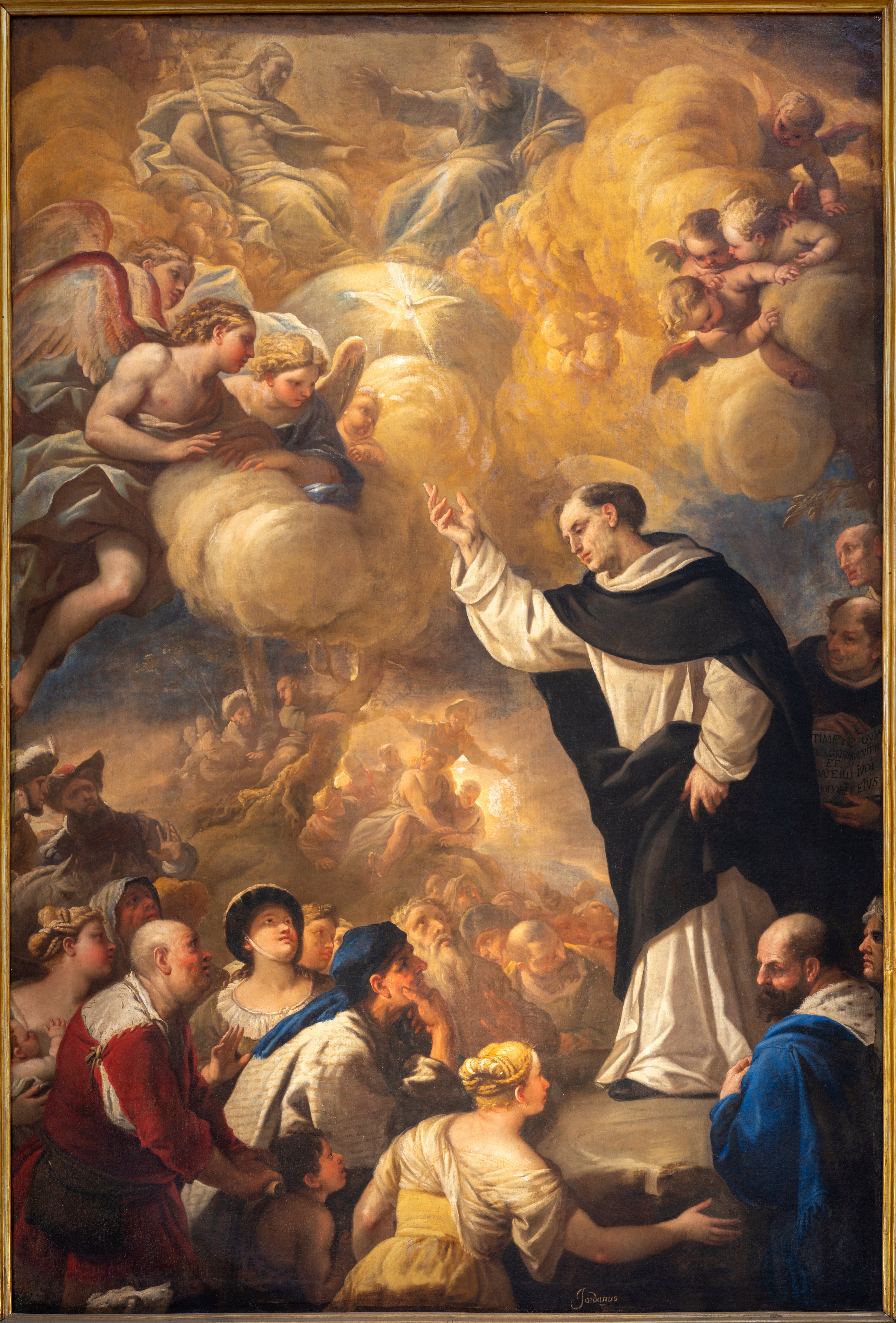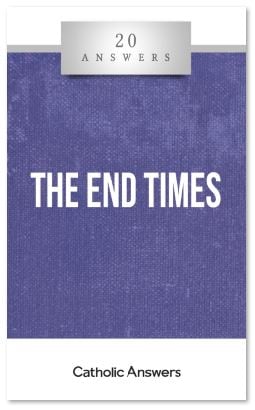
Are you Pre, Mid, or Post? If you don’t know how to answer that question, you’re probably a Catholic. Most Fundamentalists and Evangelicals know that these words are shorthand for pre-tribulation, mid-tribulation, and post-tribulation. The terms all refer to when the “rapture” is supposed to occur.
Free eBook Download | 20 Answers: End Times
The Millennium
In Revelation 20:1–3, 7–8, we read, “Then I saw an angel coming down from heaven, holding in his hand the key of the bottomless pit and a great chain. And he seized the dragon, that ancient serpent, who is the Devil and Satan, and bound him for a thousand years, and threw him into the pit, and shut it and sealed it over him, that he should deceive the nations no more, till the thousand years were ended. After that he must be loosed for a little while. . . . And when the thousand years are ended, Satan will be loosed from his prison and will come out to deceive the nations which are at the four corners of the earth.”
The period of a thousand years, the writer tells us, is the reign of Christ, and the thousand-year period is popularly called the millennium. The millennium is a harbinger of the end of the world, and Revelation 20 is interpreted in three ways by conservative Protestants. The three schools of thought are called postmillennialism, amillennialism, and premillennialism. Let’s take a look at them.
Postmillennialism
According to Loraine Boettner in his book The Millennium, postmillennialism is “that view of last things which holds that the kingdom of God is now being extended in the world through the preaching of the gospel and the saving work of the Holy Spirit, that the world eventually is to be Christianized, and that the return of Christ will occur at the close of a long period of righteousness and peace, commonly called the millennium.”
This view was popular with nineteenth-century Protestants, when progress was expected even in religion and before twentieth-century horrors were tasted. Today few hold to it, except such groups as Christian Reconstructionists, an outgrowth of the conservative Presbyterian movement.
Postmillennialists typically say that the millennium spoken of in Revelation 20 should be understood figuratively and that the phrase “a thousand years” refers not to a fixed period of ten centuries, but to an indefinitely long time. For example, Psalm 50:10 speaks of God’s sovereignty over all that is and tells us that God owns “the cattle on a thousand hills.” This is not meant to be taken literally.
At the millennium’s end will come the Second Coming, the general resurrection of the dead, and the last judgment.
The problem with postmillennialism is that Scripture does not depict the world as experiencing a period of complete (or relatively complete) Christianization before the Second Coming. There are numerous passages that speak of the age between the First and Second Comings as a time of great sorrow and strife for Christians. One revealing passage is the parable of the wheat and the weeds (Matt. 13:24–30, 36–43). In this parable, Christ declares that the righteous and the wicked will both be planted and grow alongside each other in God’s field (“the field is the world,” Matt. 13:38) until the end of the world, when they will be separated, judged, and either be thrown into the fire of hell or inherit God’s kingdom (Matt. 13:41–43). There is no biblical evidence that the world will eventually become totally (or even almost totally) Christian, but rather that there will always be a parallel development of the righteous and the wicked until the final judgment.
Amillennialism
The amillennial view interprets Revelation 20 symbolically and sees the millennium not as an earthly golden age in which the world will be totally Christianized, but as the present period of Christ’s rule in heaven and on the earth through his Church. This was the view of the Protestant Reformers and is still the most common view among traditional Protestants.
Amillennialists also believe in the coexistence of good and evil on earth until the end. The tension that exists on earth between the righteous and the wicked will be resolved only by Christ’s return at the end of time. The golden age of the millennium is instead the heavenly reign of Christ with the saints, in which the Church on earth participates to some degree, though not in the glorious way it will at the Second Coming.
Amillennialists point out that the thrones of the saints who reign with Christ during the millennium appear to be set in heaven (Rev. 20:4; cf. 4:4, 11:16) and that the text nowhere states that Christ is on earth during this reign with the saints.
They explain that, although the world will never be fully Christianized until the Second Coming, the millennium does have effects on earth in that Satan is bound in such a way that he cannot deceive the nations by hindering the preaching of the gospel (Rev. 20:3). The millennium is a golden age not when compared to the glories of the age to come, but in comparison to all prior ages of human history, in which the world was swallowed in pagan darkness.
Premillennialism
Third on the list is premillennialism, currently the most popular among Fundamentalists and Evangelicals. Most of the books written about the End Times, such as Hal Lindsey’s Late Great Planet Earth, are written from a premillennial perspective.
Like postmillennialists, premillennialists believe that the thousand years is an earthly golden age during which the world will be thoroughly Christianized. Unlike postmillennialists, they believe that it will occur after the Second Coming rather than before, so that Christ reigns physically on earth during the millennium. They believe that the Final Judgment will occur only after the millennium is over (which many interpret to be an exactly one-thousand-year period).
But Scripture does not support the idea of a thousand year span between the Second Coming and the Final Judgment. Christ declares, “For the Son of man is to come with his angels in the glory of his Father, and then he will repay every man for what he has done” (Matt. 16:27), and “[w]hen the Son of man comes in his glory, and all the angels with him, then he will sit on his glorious throne. Before him will be gathered all the nations, and he will separate them one from another as a shepherd separates the sheep from the goats. . . . And they [the goats] will go away into eternal punishment, but the righteous into eternal life” (Matt. 25:31–32, 46).
The Rapture
Premillennialists often give much attention to the doctrine of the “rapture.” According to this doctrine, when Christ returns, all of the elect who have died will be raised and transformed into a glorious state, along with the living elect, and then be caught up to be with Christ. The key text referring to the rapture is 1 Thessalonians 4:16–17, which states, “For the Lord himself will descend from heaven with a cry of command, with the archangel’s call, and with the sound of the trumpet of God. And the dead in Christ will rise first; then we who are alive, who are left, shall be caught up together with them in the clouds to meet the Lord in the air; and so we shall always be with the Lord.”
Premillennialists hold, as do virtually all Christians (except certain postmillennialists), that the Second Coming will be preceded by a time of great trouble and persecution of God’s people (2 Thess. 2:1–4). This period is often called the tribulation. Until the nineteenth century, all Christians agreed that the rapture—though it was not called that at the time—would occur immediately before the Second Coming, at the close of the period of persecution. This position is today called the “post-tribulational” view because it says the rapture will come after the tribulation.
But in the 1800s, some began to claim that the rapture would occur before the period of persecution. This position, now known as the “pre-tribulational” view, also was embraced by John Nelson Darby, an early leader of a Fundamentalist movement that became known as Dispensationalism. Darby’s pre-tribulational view of the rapture was then picked up by a man named C. I. Scofield, who taught the view in the footnotes of his Scofield Reference Bible. Many Protestants who read the Scofield Reference Bible uncritically adopted the pre-tribulational view, even though no Christian had heard of it in the previous 1800 years of Church history.
Eventually, a third position developed, known as the “mid-tribulational” view, which claims that the rapture will occur during the middle of the tribulation. (A “pre-wrath” perspective has also developed that, in summary, places the rapture after the midpoint of the tribulation, yet before the tribulation ends.) Finally, a fourth view developed that claims that there will not be a single rapture where all believers are gathered to Christ, but that there will be a series of mini-raptures that occur at different times with respect to the tribulation.
The problem with all of the positions (except the historic, post-tribulational view) is that they split the Second Coming into different events. In the case of the pre-trib view, Christ is thought to have three comings—one when he was born in Bethlehem, one when he returns for the rapture at the tribulation’s beginning, and one at tribulation’s end, when he establishes the millennium. This three-comings view is foreign to Scripture.
Problems with the pre-tribulational view are highlighted by Baptist (and premillennial) theologian Dale Moody, who wrote: “Belief in a pre-tribulational rapture . . . contradicts all three chapters in the New Testament that mention the tribulation and the rapture together (Mark 13:24–27; Matt. 24:26–31; 2 Thess. 2:1–12). . . . The theory is so biblically bankrupt that the usual defense is made using three passages that do not even mention a tribulation (John 14:3; 1 Thess. 4:17; 1 Cor. 15:52). These are important passages, but they have not had one word to say about a pre-tribulational rapture. . . . Pre-tribulationism is biblically bankrupt and does not know it” (The Word of Truth, 556–7).
What’s the Catholic Position?
As far as the millennium goes, we tend to agree with Augustine and, derivatively, with the amillennialists. The Catholic position has thus historically been “amillennial” (as has been the majority Christian position in general), though Catholics do not typically use this term. The Church has rejected the premillennial position, sometimes called “millenarianism” (see the Catechism of the Catholic Church 676). In the 1940s the Holy Office judged that premillennialism “cannot safely be taught,” though the Church has not dogmatically defined this issue.
With respect to the rapture, Catholics certainly believe that the event of our gathering together to be with Christ will take place, though they do not generally use the word “rapture” to refer to this event (somewhat ironically, since the term “rapture” is derived from the text of the Latin Vulgate of 1 Thess. 4:17—”we will be caught up,” [Latin: rapiemur]).
Do Catholics Believe in the Rapture?
Are Christians going to be taken up and out of the world before the big trouble with the anti-Christ begins? Catholics say no, that is a false view of God’s revelation regarding the end times. Karlo Broussard takes up a popular Protestant challenge: How can the Catholic Church teach that faithful Christians will experience the final trial when the Bible teaches that Christians will be raptured before such a time? Watch this video and get the answers to the rapture challenge.
Do Not Live in Fear
Many spend much time looking for signs in the heavens and in the headlines. This is especially true of premillennialists, who anxiously await the tribulation because it will inaugurate the rapture and millennium.
A more balanced perspective is given by Peter, who writes, “But do not ignore this one fact, beloved, that with the Lord one day is as a thousand years, and a thousand years as one day. . . . But according to his promise we wait for new heavens and a new earth in which righteousness dwells. Therefore, beloved, since you wait for these, be zealous to be found by him without spot or blemish, and at peace” (2 Pet. 3:8–14).
NIHIL OBSTAT: I have concluded that the materials
presented in this work are free of doctrinal or moral errors.
Bernadeane Carr, STL, Censor Librorum, August 10, 2004
IMPRIMATUR: In accord with 1983 CIC 827
permission to publish this work is hereby granted.
+Robert H. Brom, Bishop of San Diego, August 10, 2004
Saint Vincent Ferrer – The Angel of the Apocalypse

St. Vincent Ferrer Pray for Us!
Related Content
Articles
- Can we avoid the fact that the world really will end?
- Should we look forward to the end of the world?



